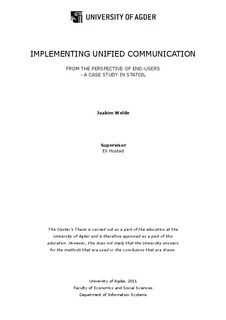| dc.description.abstract | The number of communication technologies in use have increased dramatically following the
advent of modern information technology, requiring users to learn how to use ever more devices
and systems and to choose the appropriate solution for every communication need. This adds
complexity to communication and by extension also to getting work done in general.
Unified Communication attempts to make communication and work easier by reducing the number
of devices and systems without necessarily reducing the number of technologies/channels available
to the users. The purpose of Unified Communication is thus to gather as many channels as possible
into one system, then serving this collection out to as many devices as possible in order to let the
user choose the device most appropriate for any situation. Unified Communication is a subset of
Computer-Supported Cooperative Work, from where the various types of communication involved
in a Unified Communication system are drawn.
As the products that enable Unified Communication are rather new, there is not much prior research
on how it is implemented in organizations. Research on Unified Communication is mostly limited
to proof of concept-type articles and theoretical studies on possible effects. Literature on
implementation exists, but in the form of commercial white papers. Benefits from having Unified
Communication include, but are not limited to: Cost savings through reducing travel and telephony,
employees can more easily work from home, reduced environmental impact, single number
reachability and improved information security.
To identify realized benefits to employees a study has been carried out at Statoil, a major energy
company headquartered in Norway, following the implementation of a Unified Communication
system from Microsoft centred around the products Office Communicator, Live Meeting and
Exchange Server. In all, fifteen informants were used, in two main categories: Employees that use
this system have been interviewed to identify how Unified Communication has affected their work,
also members of the project team that handled the implementation have been interviewed to gain
background information on the choices that went into building the system as used at Statoil.
The findings suggest that Unified Communication as handled through Office Communicator is a
success, albeit not an unqualified one. Users generally find the system easy to use and superior in
quality to older, separate devices and systems for telephony, instant messaging and
videoconferencing. However, not all users have learned all of the core functionality they are
required to learn if they are to transition from legacy systems to Unified Communication without
losing valuable functionality. Training courses have been offered, but have seen little attendance,
leading to a noticeable portion of employees being below the skill level where they can comfortably
handle calls or messages in all the channels offered by Communicator. Despite this, none expressed
a negative attitude toward Communicator, generally praising it as a valuable tool and well worth the
effort required to learn its use.
Additionally, Communicator had expanded on existing flexibility in terms of when and where to
work, allowing key personnel in one location or time zone to easily adapt their working hours to fit
tasks being carried out in other locations/time zones and reducing the amount of travel required.
i
This has the added benefit of giving employees more time with family and friends without reducing
the amount and quality of work these employees are able to do for Statoil.
The use and value of some communication channels such as telephony and videoconferencing was
restricted by factors external to the products involved, such as office layouts that were unfavorable
for sound-based communication or privacy concerns, also certain task-specific requirements such as
regulations requiring traceability of communications and decisions.
If suggestions are to be made, the primary issue that stands out is training and communication. The
value of Unified Communication and the products chosen depend on users having the required
skills for using the most appropriate type of communication for any context, and that each user can
assume that any colleague is able to handle any type of communication. This was handled at Statoil
during the second, international round of implementation, where class was made mandatory, but this
requirement has not been applied retrospectively to the users in Norway that got Unified
Communication in the first round of implementation. Additionally, users were generally not aware
why Unified Communication was being implemented and how this was related to older systems
being removed, nor did they have a clear impression of where and how they could get help.
This paper expands on the limited research on actual implementations of Unified Communicationsystems
and can hopefully inspire research specifically on how training affects efficiency of use as
well as provide data for comparison of Unified Communication-suites from other suppliers and in
other environments. | en_US |
